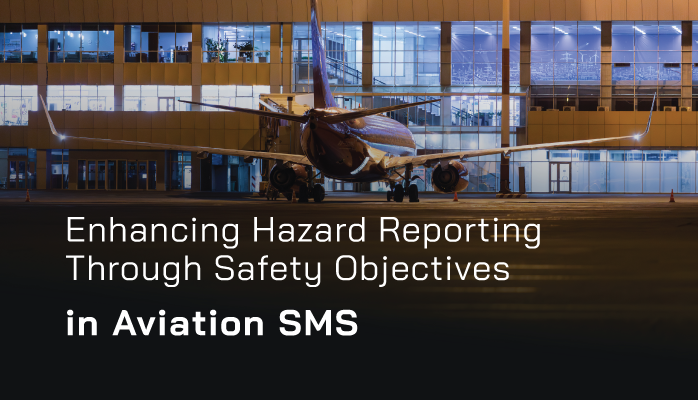Enhancing Hazard Reporting

In the fast-paced realm of aviation, safety is the ultimate priority. Every flight, maintenance procedure, and ground operation hinges on a robust safety management system (SMS) that proactively identifies and mitigates risks.
At the heart of an effective SMS lies hazard reporting—a critical process that empowers employees to flag potential safety issues before they escalate into incidents or accidents. Yet, many aviation organizations struggle with low hazard report submissions, often due to
- cultural barriers,
- lack of trust, or
- unclear expectations.
This is where safety objectives come into play. By setting clear, measurable, and employee-focused safety objectives, aviation safety managers and accountable executives can significantly
- increase hazard report submissions,
- foster a proactive safety culture, and
- enhance overall safety performance.
In this comprehensive guide, we’ll explore how safety objectives
- drive hazard reporting,
- provide actionable strategies to implement them, and
- highlight their role in building a resilient safety culture.
Related Articles on Aviation SMS Goals and Objectives
- What Are Safety Objectives in Aviation SMS – With Examples
- How to Create Safety Objectives in Aviation SMS With Examples
- The Five Elements of ICAO's Safety Policy and Objectives in SMS
Why Hazard Reporting Matters in Aviation Safety
Hazard reporting is the cornerstone of a proactive SMS. It allows frontline employees—pilots, mechanics, ground crew, and others—to identify and report conditions, behaviors, or situations that could compromise safety. These reports provide invaluable data for risk assessments, trend analysis, and corrective actions.
However, underreporting remains a pervasive challenge. According to the International Civil Aviation Organization (ICAO), organizations with low hazard reporting rates often face higher risks of undetected safety issues. Common barriers include:
- Fear of repercussions: Employees may worry about blame or disciplinary action.
- Lack of trust: A perception that reports won’t lead to meaningful change.
- Unclear processes: Confusion about how or when to report hazards.
- Cultural resistance: A mindset that reporting is unnecessary unless an incident occurs.
Safety objectives address these barriers by aligning hazard reporting with organizational goals, incentivizing participation, and creating a culture where safety is everyone’s responsibility.
The Role of Safety Objectives in Hazard Reporting

Safety objectives are specific, measurable goals within an SMS that guide safety performance and behavior. Unlike vague directives like “improve safety,” effective safety objectives are SMART: Specific, Measurable, Achievable, Relevant, and Time-bound. When designed thoughtfully, they can transform hazard reporting by:
- Clarifying Expectations: Objectives communicate that hazard reporting is a priority and a shared responsibility.
- Building Trust: By linking objectives to non-punitive reporting policies, organizations reassure employees that their contributions are valued.
- Driving Engagement: Measurable goals motivate employees to participate actively in safety processes.
- Fostering Accountability: Objectives create a framework for tracking progress and recognizing contributions.
- Promoting Proactivity: By focusing on leading indicators (e.g., number of reports submitted), objectives shift the focus from reactive incident management to proactive risk mitigation.
For example, an objective like “Increase hazard report submissions by 20% within six months through employee training and feedback” is specific, measurable, and directly tied to improving safety culture.
Related Hazard Reporting Articles
- What Good Hazard Reporting Process Look Like in Mature Aviation SMS
- Essential KPIs for Poor Hazard Reporting Cultures in Aviation SMS - With Free KPI Resources
- Safety Chart: How to Maintain Monthly Aviation SMS Hazard Reporting Goals
Strategies to Enhance Hazard Reporting Through Safety Objectives
To leverage safety objectives effectively, aviation safety managers and accountable executives must integrate them into the SMS strategically. Below are proven strategies to increase hazard report submissions and build a proactive safety culture.
1. Set Clear and Relevant Safety Objectives
Start by defining objectives that directly address hazard reporting. These should align with your organization’s safety policy and SMS framework. Examples include:
- Increase the number of hazard reports submitted by frontline staff by 25% within one year.
- Achieve a 90% resolution rate for hazard reports within 30 days to demonstrate action.
- Train 100% of employees on hazard reporting procedures within three months.
Ensure objectives are relevant to all levels of the organization, from ground crew to senior management. Involve employees in the goal-setting process to foster ownership and buy-in.
2. Promote a Non-Punitive Reporting Culture
Fear of blame is a major deterrent to hazard reporting. Safety objectives should emphasize a just culture where employees feel safe to report without fear of retribution. For instance:
- Objective: “Implement a non-punitive reporting policy and achieve 80% employee satisfaction with the reporting process within six months.”
Support this objective with actions like:
- Communicating the non-punitive policy through training and regular updates.
- Sharing anonymized success stories where hazard reports led to positive outcomes.
- Establishing confidential reporting channels to protect employee privacy.
3. Simplify and Standardize Reporting Processes
Complex or unclear reporting processes discourage participation. Safety objectives can streamline these processes to make reporting accessible and efficient. For example:
- Objective: “Reduce the average time to submit a hazard report to under five minutes by implementing a user-friendly digital safety reporting software within four months.”
Actions to achieve this include:
- Adopting mobile apps or online platforms for easy report submission.
- Standardizing report templates with clear fields (e.g., hazard description, location, potential impact).
- Providing multilingual reporting options for diverse workforces.
Related Aviation SMS Software Articles
- How to Choose Aviation SMS Software - Educating SMS Professionals
- Spreadsheets vs Software for Aviation Safety Management
- 20 Benefits of Aviation SMS Software
4. Provide Training and Awareness Campaigns
Employees need to understand what constitutes a hazard and why reporting matters. Safety objectives can drive training initiatives to build this awareness. For example:
- Objective: “Conduct quarterly hazard reporting workshops, achieving 95% employee participation annually.”
Support this with:
- Interactive training sessions that use real-world scenarios.
- Regular safety bulletins or posters reinforcing the importance of reporting.
- Gamification, such as leaderboards or rewards for departments with high reporting rates.
5. Recognize and Reward Reporting Efforts

Positive reinforcement motivates employees to engage in hazard reporting. Safety objectives can formalize recognition programs to celebrate contributions. For instance:
- Objective: “Recognize 100% of departments submitting at least five hazard reports per quarter through monthly safety awards.”
Implement this by:
- Publicly acknowledging teams or individuals (with their consent) in safety meetings or newsletters.
- Offering non-monetary rewards, such as additional training opportunities or safety-themed merchandise.
- Highlighting how reports have led to tangible safety improvements.
Related Safety Promotion Articles
- Why Safety Promotion Requires More Focus in Aviation SMS
- Aviation SMS Surveys - Most Neglected Safety Promotion Tool
- Stay on Top of Aviation Safety Promotion With SMS Newsletters
6. Monitor and Communicate Progress
Transparency builds trust. Safety objectives should include metrics to track reporting trends and share progress with employees. For example:
- Objective: “Publish a quarterly SMS dashboard showing hazard reporting trends and resolutions, achieving 85% employee awareness of outcomes.”
Actions include:
- Using data visualization tools to display reporting metrics (e.g., number of reports, resolution times).
- Sharing success stories, such as how a hazard report prevented a potential incident.
- Soliciting employee feedback to continuously improve the reporting process.
7. Integrate Hazard Reporting Into Performance Metrics
To embed hazard reporting into the organizational culture, tie it to performance evaluations at both individual and departmental levels. For example:
- Objective: “Incorporate hazard reporting participation into 100% of departmental performance reviews within one year.”
Ensure this is done constructively, focusing on participation rather than punitive measures. For instance, reward departments that consistently meet reporting targets with additional resources for safety initiatives.
Measuring the Impact of Safety Objectives
To ensure safety objectives are driving hazard reporting, track key performance indicators (KPIs) such as:
- Number of hazard reports submitted: An increase indicates greater employee engagement.
- Report resolution rate: A high rate shows that reports are being acted upon.
- Employee satisfaction with reporting processes: Surveys can gauge trust and ease of use.
- Time to resolve hazards: Faster resolutions demonstrate organizational commitment.
- Incident rate trends: A decline may reflect proactive risk mitigation.
Regularly review these KPIs to assess the effectiveness of your objectives and adjust them as needed. For example, if report submissions increase but resolution times lag, set a new objective to streamline the resolution process.
Related Aviation KPI Articles
- What Is a Key Performance Indicator (KPI) in Aviation SMS? - With Free KPI Resources
- 6 Sources for Aviation Key Performance Indicators - With Free KPI Resources
- Signs of Good KPIs in Aviation SMS
Overcoming Common Challenges
Implementing safety objectives for hazard reporting isn’t without challenges. Here’s how to address common hurdles:
- Resistance to Change: Engage employees early through town halls or focus groups to explain the benefits of increased reporting.
- Resource Constraints: Prioritize cost-effective solutions, such as free or low-cost reporting apps, and leverage existing SMS tools.
- Sustaining Momentum: Regularly refresh objectives to keep them relevant and maintain employee interest through ongoing communication.
The Long-Term Benefits of a Proactive Safety Culture
By using safety objectives to enhance hazard reporting, aviation organizations can achieve far-reaching benefits:
- Reduced Risk: More reports lead to better hazard identification and mitigation, lowering the likelihood of incidents.
- Improved Compliance: A robust hazard reporting system aligns with ICAO Annex 19 and national aviation authority requirements.
- Enhanced Employee Morale: A just culture fosters trust and empowers employees to take ownership of safety.
- Stronger Reputation: A proactive safety culture enhances stakeholder confidence, from regulators to passengers.
Ultimately, safety objectives transform hazard reporting from a compliance exercise into a cornerstone of organizational excellence.
Related Proactive Risk Management Articles
- Difference Between Reactive, Predictive and Proactive Risk Management in Aviation SMS
- Reactive or Proactive Safety Culture? 5 Creative Ways to Tell
- 3 Things You Are Doing to Hurt Proactive Risk Management in Aviation SMS
Conclusion: Take Action Today
For aviation safety managers and accountable executives, enhancing hazard reporting through safety objectives is a powerful strategy to build a proactive safety culture. By setting clear goals, promoting a just culture, simplifying processes, and recognizing contributions, you can unlock the full potential of your SMS and ensure safer skies.
Start by assessing your current hazard reporting rates and identifying barriers within your organization. Then, craft SMART safety objectives tailored to your needs and implement the strategies outlined above. With commitment and consistency, you’ll not only increase hazard report submissions but also foster a culture where safety thrives.
Ready to take the next step? Review your SMS, engage your team, and set safety objectives that drive meaningful change. The future of aviation safety starts with you.
If you need tools to improve your safety reporting culture, SMS Pro is here to help.










